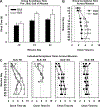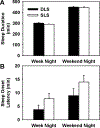Effects of dynamic lighting on circadian phase, self-reported sleep and performance during a 45-day space analog mission with chronic variable sleep deficiency
- PMID: 35996978
- PMCID: PMC11316501
- DOI: 10.1111/jpi.12826
Effects of dynamic lighting on circadian phase, self-reported sleep and performance during a 45-day space analog mission with chronic variable sleep deficiency
Abstract
Spaceflight exposes crewmembers to circadian misalignment and sleep loss, which impair cognition and increase the risk of errors and accidents. We compared the effects of an experimental dynamic lighting schedule (DLS) with a standard static lighting schedule (SLS) on circadian phase, self-reported sleep and cognition during a 45-day simulated space mission. Sixteen participants (mean age [±SD] 37.4 ± 6.7 years; 5 F; n = 8/lighting condition) were studied in four-person teams at the NASA Human Exploration Research Analog. Participants were scheduled to sleep 8 h/night on two weekend nights, 5 h/night on five weekday nights, repeated for six 7-day cycles, with scheduled waketime fixed at 7:00 a.m. Compared to the SLS where illuminance and spectrum remained constant during wake (~4000K), DLS increased the illuminance and short-wavelength (blue) content of white light (~6000K) approximately threefold in the main workspace (Level 1), until 3 h before bedtime when illuminance was reduced by ~96% and the blue content also reduced throughout (~4000K × 2 h, ~3000K × 1 h) until bedtime. The average (±SE) urinary 6-sulphatoxymelatonin (aMT6s) acrophase time was significantly later in the SLS (6.22 ± 0.34 h) compared to the DLS (4.76 ± 0.53 h) and more variable in SLS compared to DLS (37.2 ± 3.6 min vs. 28.2 ± 2.4 min, respectively, p = .04). Compared to DLS, self-reported sleep was more frequently misaligned relative to circadian phase in SLS RR: 6.75, 95% CI 1.55-29.36, p = .01), but neither self-reported sleep duration nor latency to sleep was different between lighting conditions. Accuracy in the abstract matching and matrix reasoning tests were significantly better in DLS compared to SLS (false discovery rate-adjusted p ≤ .04). Overall, DLS alleviated the drift in circadian phase typically observed in space analog studies and reduced the prevalence of self-reported sleep episodes occurring at an adverse circadian phase. Our results support incorporating DLS in future missions, which may facilitate appropriate circadian alignment and reduce the risk of sleep disruption.
Keywords: circadian; dynamic lighting; light; melanopsin; melatonin; performance; sleep; spaceflight.
© 2022 John Wiley & Sons A/S. Published by John Wiley & Sons Ltd.
Conflict of interest statement
Competing interests.
SAR holds patents for (1) Prevention of circadian rhythm disruption by using optical filters and (2) Improving sleep performance in subject exposed to light at night; SAR owns equity in Melcort Inc.; has provided paid consulting services to Sultan & Knight Limited, Bambu Vault LLC, Lucidity Lighting Inc.; and has received honoraria as an invited speaker and travel funds from Starry Skies Lake Superior, University of Minnesota Medical School, PennWell Corp., and Seoul Semiconductor Co. Ltd. These interests were reviewed and managed by Brigham and Women’s Hospital and Partners HealthCare in accordance with their conflict of interest policies. BAK, LKG, TC, report no conflicts. JPH reports being a paid consultant by Lutron, Inc. and McCullough Hill LLC. LKB reports personal fees from Boston Children’s Hospital, University of Helsinki and the AAA Foundation. CAC reports grants and contracts to BWH from Dayzz Live Well, Delta Airlines, Jazz Pharma, Puget Sound Pilots, Regeneron Pharmaceuticals/Sanofi; is/was paid consultant/speaker for Inselspital Bern, Institute of Digital Media and Child Development, Klarman Family Foundation, M. Davis and Co, National Council for Mental Wellbeing, National Sleep Foundation, Physician’s Seal, SRS Foundation, State of Washington Board of Pilotage Commissioners, Tencent, Teva Pharma Australia, With Deep, and Vanda Pharmaceuticals, in which CAC holds an equity interest; received travel support from Aspen Brain Institute, Bloomage International Investment Group, Inc., Dr. Stanley Ho Medical Development Foundation, German National Academy of Sciences, Ludwig-Maximilians-Universität München, National Highway Transportation Safety Administration, National Safety Council, National Sleep Foundation, Salk Institute for Biological Studies/Fondation Ipsen, Society for Research on Biological Rhythms, Stanford Medical School Alumni Association, Tencent Holdings, Ltd, and Vanda Pharmaceuticals; receives research/education gifts through BWH from Arbor Pharmaceuticals, Avadel Pharmaceuticals, Bryte, Alexandra Drane, Cephalon, DR Capital Ltd, Eisai, Harmony Biosciences, Jazz Pharmaceuticals, Johnson & Johnson, Mary Ann & Stanley Snider via Combined Jewish Philanthropies, NeuroCare, Inc., Optum, Philips Respironics, Regeneron, Regional Home Care, ResMed, Resnick Foundation (The Wonderful Company), San Francisco Bar Pilots, Sanofi SA, Schneider, Simmons, Sleep Cycle AB. Sleep Number, Sysco, Teva Pharmaceuticals, Vanda Pharmaceuticals; is/was an expert witness in legal cases, including those involving Advanced Power Technologies, Aegis Chemical Solutions, Amtrak; Casper Sleep Inc, C&J Energy Services, Catapult Energy Services Group, Covenant Testing Technologies, Dallas Police Association, Enterprise Rent-A-Car, Espinal Trucking/Eagle Transport Group/Steel Warehouse Inc, FedEx, Greyhound, Pomerado Hospital/Palomar Health District, PAR Electrical Contractors, Product & Logistics Services LLC/Schlumberger Technology, Puckett EMS, Puget Sound Pilots, Union Pacific Railroad, UPS, and Vanda Pharmaceuticals; serves as the incumbent of an endowed professorship given to Harvard by Cephalon; and receives royalties from McGraw Hill and Philips Respironics for the Actiwatch-2 and Actiwatch Spectrum devices. CAC’s interests were reviewed and are managed by the Brigham and Women’s Hospital and Mass General Brigham in accordance with their conflict-of-interest policies. GCB has no conflicts of interest relative to the scientific content of this manuscript. In the spirit of open disclosure, however, he reports having issued patents (USPTO 7678140 B2; 10603507; 10213619 B2 and 8366755 B2) and pending patents (USPTO 16/831737 and 16/657927) related to the photoreceptor system for melatonin regulation. That intellectual property has been licensed by Litebook Company Ltd. He has been a paid consultant by Lutron, Inc. and McCullough Hill LLC. He currently serves on a Scientific Advisory Board for PhotoPharmics. In addition, The Thomas Jefferson University’s Light Research Program (LRP) has received equipment donations from industry partners including Toshiba Materials, BIOS, Robern, and PhotoPharmics Company. The Philadelphia section of the IES, BIOS, Robern and Toshiba have made gifts to the LRP for programmatic, research and educational uses. MASH has provided limited consulting to The MathWorks, Inc. SWL (2018–2021) has received consulting fees from the BHP Billiton, EyeJust Inc., Lighting Science Group corporation/HealthE, Noble Insights, Rec Room, Six Senses, Stantec and Team C Racing; and has current consulting contracts with Akili Interactive, Apex 2100 Ltd., Consumer Sleep Solutions, Headwaters Inc., Hintsa Performance AG, KBR Wyle Services, Light Cognitive, Mental Workout/Timeshifter, and View Inc. He has received honoraria and travel or accommodation expenses from Bloxhub, Emory University, Estée Lauder, Ineos, MIT, Roxbury Latin School, and University of Toronto, and travel or accommodation expenses (no honoraria) from IES, Mental Workout, Solemma, and Wiley; and royalties from Oxford University Press. He holds equity in iSleep pty. He has received an unrestricted equipment gift from F. Lux Software LLC, a fellowship gift from Stockgrand Ltd and holds an investigator-initiated grant from F. Lux Software LLC and a Clinical Research Support Agreement and Clinical Trial Agreement with Vanda Pharmaceuticals Inc. He is an unpaid Board Member of the Midwest Lighting Institute (non-profit). He was a Program Leader for the CRC for Alertness, Safety and Productivity, Australia, through an adjunct professor position at Monash University (2015–2019). He is part-time adjunct professor at the University of Surrey, UK. He holds a pending patent for a ‘Method and system for generating and providing notifications for a circadian shift protocol’ (US20190366032A1). He has served as a paid expert in legal proceedings related to light, sleep and health.
Figures



Similar articles
-
The effect of a dynamic lighting schedule on neurobehavioral performance during a 45-day simulated space mission.Sleep Adv. 2024 May 30;5(1):zpae032. doi: 10.1093/sleepadvances/zpae032. eCollection 2024. Sleep Adv. 2024. PMID: 38903700 Free PMC article.
-
Dynamic lighting schedules to facilitate circadian adaptation to shifted timing of sleep and wake.J Pineal Res. 2022 Aug;73(1):e12805. doi: 10.1111/jpi.12805. Epub 2022 May 25. J Pineal Res. 2022. PMID: 35501292 Free PMC article.
-
The role of circadian phase in sleep and performance during Antarctic winter expeditions.J Pineal Res. 2022 Sep;73(2):e12817. doi: 10.1111/jpi.12817. Epub 2022 Jul 25. J Pineal Res. 2022. PMID: 35833316 Free PMC article.
-
The development of lighting countermeasures for sleep disruption and circadian misalignment during spaceflight.Curr Opin Pulm Med. 2016 Nov;22(6):535-44. doi: 10.1097/MCP.0000000000000329. Curr Opin Pulm Med. 2016. PMID: 27607152 Review.
-
Electric lighting, adolescent sleep and circadian outcomes, and recommendations for improving light health.Sleep Med Rev. 2022 Aug;64:101667. doi: 10.1016/j.smrv.2022.101667. Epub 2022 Aug 12. Sleep Med Rev. 2022. PMID: 36064209 Free PMC article. Review.
Cited by
-
Changes to human sleep architecture during long-duration spaceflight.J Sleep Res. 2025 Jun;34(3):e14345. doi: 10.1111/jsr.14345. Epub 2024 Nov 10. J Sleep Res. 2025. PMID: 39523514 Free PMC article.
-
[Effects of Extreme Environments on Human Sleep].Sichuan Da Xue Xue Bao Yi Xue Ban. 2024 Jul 20;55(4):1034-1043. doi: 10.12182/20240760402. Sichuan Da Xue Xue Bao Yi Xue Ban. 2024. PMID: 39170010 Free PMC article. Review. Chinese.
-
Time-Dependent Effects of Altered Prebedtime Light Exposure in Enclosed Spaces on Sleep Performance Associated with Human States.Nat Sci Sleep. 2024 Aug 6;16:1179-1200. doi: 10.2147/NSS.S472988. eCollection 2024. Nat Sci Sleep. 2024. PMID: 39131165 Free PMC article.
-
Dry eye disease in astronauts: a narrative review.Front Physiol. 2023 Oct 19;14:1281327. doi: 10.3389/fphys.2023.1281327. eCollection 2023. Front Physiol. 2023. PMID: 37929210 Free PMC article. Review.
-
Spaceflight-Induced Gene Expression Profiles in the Mouse Brain Are Attenuated by Treatment with the Antioxidant BuOE.Int J Mol Sci. 2023 Sep 1;24(17):13569. doi: 10.3390/ijms241713569. Int J Mol Sci. 2023. PMID: 37686374 Free PMC article.
References
-
- Barger LK, Wright KP, Burke TM et al. (2014). Sleep and cognitive function of crewmembers and mission controllers working 24-h shifts during a simulated 105-day spaceflight mission. Acta Astronautica, 93, 230–242.
MeSH terms
Substances
Grants and funding
LinkOut - more resources
Full Text Sources

